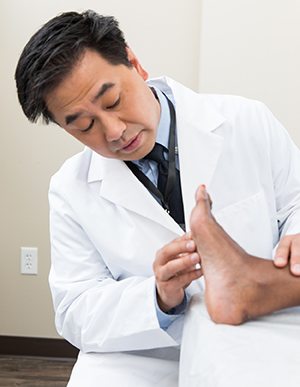Diabetes makes it harder for the body to heal. Diabetes can also cause nerve damage. This means you might not feel a sore on your foot. Even minor foot problems, like a blister, can become infected. If not treated, infections can spread and damage nearby tissues. You may need treatment in the hospital. Serious infections can result in loss of a toe or foot. Quick care by your doctor can help clear up infections and prevent serious problems.
Take care of your feet
When you have diabetes, caring for your feet is very important in preventing serious foot problems. Take care of your feet by doing the following:
-
Wash your feet thoroughly every day.
-
Dry them well. Don’t forget to dry between your toes.
-
Moisturize your feet. But try not to moisturize between your toes.
-
Keep your toenails trim. Use an emery board to file down sharp edges.
-
Check your feet for sores, cuts, blisters, corns, or redness daily. Let your doctor know if you find any.
-
Wear moisture-wicking socks.
-
Before putting your shoes on, check for sharp objects (such as small rocks).
-
Wear shoes that fit well and don’t rub your feet.
Get treatment
If your doctor finds a minor foot infection, you’ll start treatment. The goal is to heal the infected area. You'll also need to prevent spread of the infection. Follow all treatment directions from your health care team.
-
Your doctor will check and clean the infected part.
-
They will measure the length, width, and depth of the infected area. That way, your wound care team can tell if the wound is healing or getting larger from one visit to the next.
-
If your doctor prescribed antibiotics, take them as directed. Do not stop taking them, even if the sore starts to look better. You need to take the full course of antibiotics.
-
Your doctor may change your diabetes medicines to better control your blood sugar.
-
You may be asked to keep the infected area dry.
-
You may be told to keep your feet raised or to limit walking. Swelling of the foot with fluid can slow wound healing. You may also be fitted with a cast or another type of special shoe. This can take the pressure off the injured area.
-
Follow any directions you are given about changing bandages. Some dressings or gels include special ingredients to help the wound heal.
Follow-up care
When you have diabetes, a foot infection may take a long time to heal. That may even be the case if you take antibiotics or have other treatments. For best results, be sure to keep all your follow-up visits with your doctor. They can then make sure you’re healing the right way.
When to contact your doctor
Check your feet every day. Use a mirror to look at the bottoms. Also check between your toes. Contact your doctor right away if you have any open or infected areas on your feet. You might be able to take a picture of the open area with your smartphone to send to your doctor. Watch for these signs of an infection:
-
Soreness
-
Redness
-
Warmth
-
Swelling
-
Drainage
-
Fever of 100.4°F (38°C) or higher, or as directed by your doctor
Also contact your doctor if:
-
Corns, calluses, sores, cuts, blisters, or bunions appear on your feet
-
Your feet or legs swell.
-
You have an ingrown toenail.
-
You have itching or cracking between your toes.
-
Your feet are constantly cold.
-
You have pain or cramps in your legs or feet while walking.
-
Your skin color changes.


